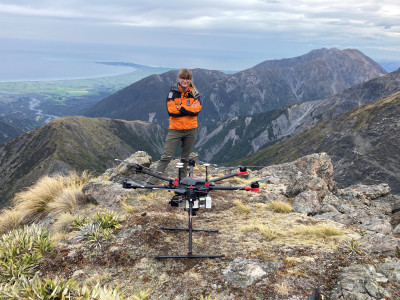Drone pilots stand to create a thousand new science frontiers with the help of GETS
Science agency pilots are training up to fly drones in new ways.

Regine Morgenstern, paleoseismology technician out in the field.
GNS Science Te Pū Ao used GETS to find a supplier who could help train their drone pilots to operate under Civil Aviation Authority Part 102 and open up the capabilities of their drone usage.
Regine Morgenstern, Senior Technician at GNS and project lead, said the new certification would allow for more freedom outside of the standard drone operating rules.
GNS Science uses drones routinely for research, commercial and event response activities to acquire data and samples in an efficient, cost-effective and safe way. But now the work programme is changing. There is demand for drones to be used in ways they haven’t been used before.
“At the moment GNS drone pilots fly under Part 101 rules. We want our pilots and drones to be able to fly under Part 102 to be able to do complex and technical tasks more efficiently in the field. Some of the operations on our horizon need heavier drones to extract samples from volcanic craters and thermal infrared surveys to be conducted in geothermal areas at night, unshielded.
“As technology and the regulatory environment change, we are keen to unlock the potential of drone operations beyond Part 101 restrictions.”
Training pilots up for Part 102 means the drone operators are more experienced and better pilots, said Regine.
“Most of our drone operations are to support natural hazard and risk research and event response. This certification will provide the space and flexibility to design innovative and bespoke solutions. Previously, this type of work was carried out by crewed aircraft or ground personnel. Using drones has made this work faster, cheaper and safer in general.”
Procurement specialist Sophie Crooks was excited to be involved on the project.
“It’s helping find a solution to make the best use of new technology and support GNS’s goal to deliver impactful science through the use of drones.
“In line with our procurement policy, it was important for us to go out to market via GETS to find the most competitive offer and to mitigate the risks associated with this project.”
Using GETS to source a supplier was straightforward, she said.
“GNS went to market with a clear set of requirements, deliverables, and timelines.
“The platform is easy to use and enables centralised communication with all interested parties, making sure all prospective respondents receive the same information.
“Through the use of GETS, we were made aware of some additional suppliers who operate in the drone industry. It was interesting and a good way to find out about these suppliers’ expertise and areas of business. Without GETS, our view would have narrowed and closed GNS off to potential opportunities working with these smaller, local suppliers.”
Interesting facts about the GNS drone pilots and drones:
- GNS has been operating drones since about 2016.
- GNS currently operates about 20 drones and has roughly the same number of drone pilots.
- GNS uses drone technology for fieldwork all around the country as well as overseas. Part 102 drones are intended to be operated in areas including Taupō Volcanic Zone geothermal areas, Hawke’s Bay Cape Kidnappers beach and West Coast glacier valleys.